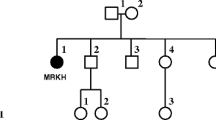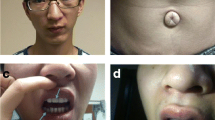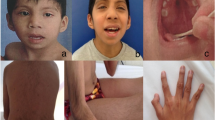Abstract
We report a young boy with penoscrotal hypospadias, anal atresia (AA) with a recto-urethral fistula, a hypoplastic kidney and a balanced translocation t(6;17)(p21.31;q11.2). Physical mapping of the breakpoints localized the chromosome 6 breakpoint within an intron of the gene lipoma HMGIC fusion partner-like 5 (LHFPL5) whereas the chromosome 17 breakpoint was mapped to the first intron of the 182-FIP gene encoding the Fragile X Mental Retardation Protein Interacting Protein. Sequence analysis across the breakpoints revealed an almost perfectly balanced translocation with a 2 bp deletion on the derivative chromosome 6 and a 7 bp duplication on the derivative chromosome 17. We identified a fusion transcript consisting of the first exon of 182-FIP and the last exon of LHFPL5 in patient-derived cells. Quantitative expression analysis of the genes flanking the breakpoints, revealed increased transcript levels for SFRS protein kinase 1 (SRPK1) and TAO kinase 1 (TAOK1) which suggests a positional effect due to the translocation. We hypothesize that the urogenital and anorectal malformations in the patient result from one or several mechanisms including disruption of the genes 182-FIP and LHFPL5, altered expression of the genes flanking the translocation breakpoints and, a gain of function mechanism mediated by the 182-FIP-LHFPL5 fusion transcript.



Similar content being viewed by others
Reference
Abeysinghe SS, Chuzhanova N, Krawczak M, Ball EV, Cooper DN (2003) Translocation and gross deletion breakpoints in human inherited disease and cancer I: Nucleotide composition and recombination-associated motifs. Hum Mutat 22:229–44
Baptista J, Prigmore E, Gribble SM, Jacobs PA, Carter NP, Crolla JA (2005) Molecular cytogenetic analyses of breakpoints in apparently balanced reciprocal translocations carried by phenotypically normal individuals. Eur J Hum Genet 13:1205–12
Bardoni B, Castets M, Huot ME, Schenck A, Adinolfi S, Corbin F, Pastore A, Khandjian EW, Mandel JL (2003) 82-FIP, a novel FMRP (fragile X mental retardation protein) interacting protein, shows a cell cycle-dependent intracellular localization. Hum Mol Genet 12:1689–98
Bartsch O, Kuhnle U, Wu LL, Schwinger E, Hinkel GK (1996) Evidence for a critical region for penoscrotal inversion, hypospadias, and imperforate anus within chromosomal region 13q32.2q34. Am J Med Genet 65:218–21
Baskin LS (2000) Hypospadias and urethral development. J Urol 163:951–6
Cho S, Moore SP, Fangman T (2001) One hundred three consecutive patients with anorectal malformations and their associated anomalies. Arch Pediatr Adolesc Med 155:587–91
Christensen K, Madsen CM, Hauge M, Kock K (1990) An epidemiological study of congenital anorectal malformations: 15 Danish birth cohorts followed for 7 years. Paediatr Perinat Epidemiol 4:269–75
de Santa Barbara P, Roberts DJ (2002) Tail gut endoderm and gut/genitourinary/tail development: a new tissue-specific role for Hoxa13. Development 129:551–61
Dravis C, Yokoyama N, Chumley MJ, Cowan CA, Silvany RE, Shay J, Baker LA, Henkemeyer M (2004) Bidirectional signaling mediated by ephrin-B2 and EphB2 controls urorectal development. Dev Biol 271:272–90
Endo M, Hayashi A, Ishihara M, Maie M, Nagasaki A, Nishi T, Saeki M (1999) Analysis of 1,992 patients with anorectal malformations over the past two decades in Japan. Steering Committee of Japanese Study Group of Anorectal Anomalies. J Pediatr Surg 34:435–41
Fredell L, Lichtenstein P, Pedersen NL, Svensson J, Nordenskjold A (1998) Hypospadias is related to birth weight in discordant monozygotic twins. J Urol 160:2197–9
Gallentine ML, Morey AF, Thompson IM, Jr. (2001) Hypospadias: a contemporary epidemiologic assessment. Urology 57:788–90
Gui JF, Lane WS, Fu XD (1994) A serine kinase regulates intracellular localization of splicing factors in the cell cycle. Nature 369:678–82
Haraguchi R, Mo R, Hui C, Motoyama J, Makino S, Shiroishi T, Gaffield W, Yamada G (2001) Unique functions of Sonic hedgehog signaling during external genitalia development. Development 128:4241–50
Haraguchi R, Suzuki K, Murakami R, Sakai M, Kamikawa M, Kengaku M, Sekine K, Kawano H, Kato S, Ueno N, Yamada G (2000) Molecular analysis of external genitalia formation: the role of fibroblast growth factor (Fgf) genes during genital tubercle formation. Development 127:2471–9
Hassink EA, Rieu PN, Hamel BC, Severijnen RS, vd Staak FH, Festen C (1996) Additional congenital defects in anorectal malformations. Eur J Pediatr 155:477–82
Hori T, Giuffra E, Andersson L, Ohkawa H (2001) Mapping loci causing susceptibility to anal atresia in pigs, using a resource pedigree. J Pediatr Surg 36:1370–4
Kato M, Seki N, Sugano S, Hashimoto K, Masuho Y, Muramatsu M, Kaibuchi K, Nakafuku M (2001) Identification of sonic hedgehog-responsive genes using cDNA microarray. Biochem Biophys Res Commun 289:472–8
Kimmel SG, Mo R, Hui CC, Kim PC (2000) New mouse models of congenital anorectal malformations. J Pediatr Surg 35:227–30; discussion 230–1
Klar J, Asling B, Carlsson B, Ulvsback M, Dellsen A, Strom C, Rhedin M, Forslund A, Anneren G, Ludvigsson JF, Dahl N (2005) RAR-related orphan receptor A isoform 1 (RORa1) is disrupted by a balanced translocation t(4;15)(q22.3;q21.3) associated with severe obesity. Eur J Hum Genet 13:928–34
Longo-Guess CM, Gagnon LH, Cook SA, Wu J, Zheng QY, Johnson KR (2005) A missense mutation in the previously undescribed gene Tmhs underlies deafness in hurry-scurry (hscy) mice. Proc Natl Acad Sci USA 102:7894–9
Mansouri MR, Marklund L, Gustavsson P, Davey E, Carlsson B, Larsson C, White I, Gustavson KH, Dahl N (2005) Loss of ZDHHC15 expression in a woman with a balanced translocation t(X;15)(q13.3;cen) and severe mental retardation. Eur J Hum Genet 13:970–7
Martinez-Frias ML (1994) Epidemiological analysis of outcomes of pregnancy in diabetic mothers: identification of the most characteristic and most frequent congenital anomalies. Am J Med Genet 51:108–13
Martinez-Frias ML, Bermejo E, Rodriguez-Pinilla E (2000) Anal atresia, vertebral, genital, and urinary tract anomalies: a primary polytopic developmental field defect identified through an epidemiological analysis of associations. Am J Med Genet 95:169–73
Martinez-Frias ML, Frias JL (1999) VACTERL as primary, polytopic developmental field defects. Am J Med Genet 83:13–6
Morgan EA, Nguyen SB, Scott V, Stadler HS (2003) Loss of Bmp7 and Fgf8 signaling in Hoxa13-mutant mice causes hypospadia. Development 130:3095–109
Mortlock DP, Innis JW (1997) Mutation of HOXA13 in hand-foot-genital syndrome. Nat Genet 15:179–80
Nordenskjold A, Friedman E, Tapper-Persson M, Soderhall C, Leviav A, Svensson J, Anvret M (1999) Screening for mutations in candidate genes for hypospadias. Urol Res 27:49–55
Paulozzi LJ (1999) International trends in rates of hypospadias and cryptorchidism. Environ Health Perspect 107:297–302
Pelletier J, Bruening W, Kashtan CE, Mauer SM, Manivel JC, Striegel JE, Houghton DC, Junien C, Habib R, Fouser L, et al. (1991) Germline mutations in the Wilms’ tumor suppressor gene are associated with abnormal urogenital development in Denys-Drash syndrome. Cell 67:437–47
Perriton CL, Powles N, Chiang C, Maconochie MK, Cohn MJ (2002) Sonic hedgehog signaling from the urethral epithelium controls external genital development. Dev Biol 247:26–46
Podlasek CA, Duboule D, Bushman W (1997) Male accessory sex organ morphogenesis is altered by loss of function of Hoxd-13. Dev Dyn 208:454–65
Rodono A, Romeo MG, Sanges G, Distefano G (1997) [CHARGE association: report of a clinical case with anal atresia and rectovaginal fistula]. Pediatr Med Chir 19:469–71
Sasaki Y, Iwai N, Tsuda T, Kimura O (2004) Sonic hedgehog and bone morphogenetic protein 4 expressions in the hindgut region of murine embryos with anorectal malformations. J Pediatr Surg 39: 170–3; discussion 170–3
Sebat J, Lakshmi B, Troge J, Alexander J, Young J, Lundin P, Maner S, Massa H, Walker M, Chi M, Navin N, Lucito R, Healy J, Hicks J, Ye K, Reiner A, Gilliam TC, Trask B, Patterson N, Zetterberg A, Wigler M (2004) Large-scale copy number polymorphism in the human genome. Science 305:525–8
Seri M, Martucciello G, Paleari L, Bolino A, Priolo M, Salemi G, Forabosco P, Caroli F, Cusano R, Tocco T, Lerone M, Cama A, Torre M, Guys JM, Romeo G, Jasonni V (1999) Exclusion of the Sonic Hedgehog gene as responsible for Currarino syndrome and anorectal malformations with sacral hypodevelopment. Hum Genet 104:108–10
Shaul DB, Harrison EA (1997) Classification of anorectal malformations–initial approach, diagnostic tests, and colostomy. Semin Pediatr Surg 6:187–95
Stadler HS (2003) Modelling genitourinary defects in mice: an emerging genetic and developmental system. Nat Rev Genet 4:478–82
Steinbach P, Rehder H (1987) Tetrasomy for the short arm of chromosome 12 with accessory isochromosome (+i(12p] and a marked LDH-B gene dosage effect. Clin Genet 32:1–4
Sutherland RW, Wiener JS, Hicks JP, Marcelli M, Gonzales ET, Jr., Roth DR, Lamb DJ (1996) Androgen receptor gene mutations are rarely associated with isolated penile hypospadias. J Urol 156:828–31
Takano T, Yamanouchi Y, Mori Y, Kudo S, Nakayama T, Sugiura M, Hashira S, Abe T (1997) Interstitial deletion of chromosome 1q [del(1)(q24q25.3)] identified by fluorescence in situ hybridization and gene dosage analysis of apolipoprotein A-II, coagulation factor V, and antithrombin III. Am J Med Genet 68:207–10
Tentler D, Johannesson T, Johansson M, Rastam M, Gillberg C, Orsmark C, Carlsson B, Wahlstrom J, Dahl N (2003) A candidate region for Asperger syndrome defined by two 17p breakpoints. Eur J Hum Genet 11:189–95
Van Buggenhout G, Trommelen J, Hamel B, Fryns JP (1999) 13q deletion syndrome in an adult mentally retarded patient. Genet Couns 10:177–81
Warburton D (1991) De novo balanced chromosome rearrangements and extra marker chromosomes identified at prenatal diagnosis: clinical significance and distribution of breakpoints. Am J Hum Genet 49:995–1013
Warot X, Fromental-Ramain C, Fraulob V, Chambon P, Dolle P (1997) Gene dosage-dependent effects of the Hoxa-13 and Hoxd-13 mutations on morphogenesis of the terminal parts of the digestive and urogenital tracts. Development 124:4781–91
Zlotogora J, Abu-Dalu K, Lernau O, Sagi M, Voss R, Cohen T (1989) Anorectal malformations and Down syndrome. Am J Med Genet 34:330–1
Acknowledgments
We would like to thank the patient and his family for their contribution to this study. This work was supported by grants from the Swedish Research Council, the Swedish Cancer Society, The Sävstaholm Society, Torsten and Ragnar Söderbergs Fund, the Borgström Foundation and Uppsala University. We would also like to thank Mats Gustafsson, Department of Genetics and Pathology at Uppsala University, for his help with the statistics. The study was approved by the appropriate Swedish review board and an informed consent was obtained.
Author information
Authors and Affiliations
Corresponding author
Rights and permissions
About this article
Cite this article
Mansouri, M.R., Carlsson, B., Davey, E. et al. Molecular genetic analysis of a de novo balanced translocation t(6;17)(p21.31;q11.2) associated with hypospadias and anorectal malformation. Hum Genet 119, 162–168 (2006). https://doi.org/10.1007/s00439-005-0122-9
Received:
Accepted:
Published:
Issue Date:
DOI: https://doi.org/10.1007/s00439-005-0122-9




